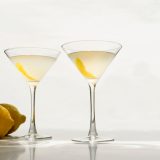Custom infused liquor is the sort of pro-grade ingredient that separates home and professional mixologists.
It doesn't have to.
Infused liquors—whether bacon in bourbon or vanilla in vodka—allow the crafting of cocktails with nuance, the painting of flavor in fine detail. But conventional wisdom is that infusing is a slow and persnickety process.
Traditional infusions call for letting a flavorful ingredient—fruit, spices or fresh herbs, for example—steep in a liquor (neutral is best) for at least a day, but often for a week or more, then straining.
That's crazy talk. We get better results in about 5 minutes. Our secret? The blender.
Infusion occurs when the flavorful oils and/or juices from an ingredient seep into an alcohol. The speed at which this occurs depends entirely on the integrity of the cells of the flavoring ingredient.
Place an unblemished sprig of rosemary in vodka and it could take days for the flavor to permeate. Bruise the sprig and you'll speed it up. Crush it, faster still. Mash and mince it? You get the idea.
For the best flavor-to-speed ratio, we combine our liquor and flavoring agent in a blender, then pulse briefly until finely chopped (don't puree). Give it five to 10 minutes, then strain (a mesh strainer is best) and consume.
Our preferred liquor is vodka, which easily adopts just about any flavor. In summer, we use fruit—mangos, plums, peaches, berries. Just blend briefly, let rest, then strain (press the solids to extract), then drink neat, on ice or in a cocktail.
In cooler months, we use fresh herbs, such as rosemary, sage and lemon grass. Fresh ginger, chilies and fresh horseradish also are good.
For 1 cup of vodka, we gave the liquor a distinct but not overwhelming flavor using one of the following: three sprigs of fresh sage (15 grams), 8 sprigs fresh rosemary (15 grams), a 3-inch chunk of peeled ginger (40 grams), a 2-inch piece of peeled horseradish (25 grams) or 2½ serrano chilies (25 grams).




